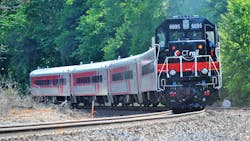Projects in four states have been awarded $55.8 million by the Federal Railroad Administration (FRA) through the Consolidated Rail Infrastructure and Safety Improvements (CRISI) grant program that will bring benefits to passenger rail services.
Congressional offices were notified last week that projects in Colorado, Connecticut, Maine and Illinois will receive the CRISI grants, which help fund freight and passenger rail projects that increase rail transportation safety, efficiency and reliability. FRA had $244 million available to award through the program in FY19. A full list of CRISI grant awardees is expected to be released this week.
The Colorado Department of Transportation (CDOT), in partnership with the Southwest Chief and Front Range Passenger Rail Commission, has been awarded $225,000 for the Southwest Chief Thru-Car Service to Colorado Springs Feasibility Study. The study would look at the possibility of extending Southwest Chief service to Colorado Springs.
“I’m pleased that the [U.S.] Department of Transportation awarded this grant to study the feasibility of extending service, which has the potential to bolster transportation connectivity and support our communities,” said U.S. Sen. Cory Gardner (R-CO).
U.S. Sen. Michael Bennet (D-CO) added, “This grant will allow CDOT and the Southwest Chief and Front Range Passenger Rail Commission to explore the ways in which we can improve accessibility and to continue to provide vital services to rural Coloradans.”
In Maine, the Northern New England Passenger Rail Authority (NNEPRA) has been awarded a $16.8 million to make rail infrastructure upgrades in Wells, North Berwick and Brunswick. The Downeaster service connects Brunswick, Maine to Boston, Mass., and is managed by NNEPRA and operated by Amtrak.
NNEPRA will construct a six-mile extension of an existing two-mile passing siding on the Pan Am Railway's Freight Main Line in Wells, along with a new passenger platform and pedestrian bridge at the Wells Transportation Center (Wells Station). The improvements will provide needed capacity to meet projected increased passenger demand, freight demand, reduce interference delays between freight and passenger trains and allow the addition of a sixth round trip each day between Brunswick and Wells.
“In the recent years, the Downeaster has set new records for both ridership and ticket revenue. It is an economic engine for Maine, providing good jobs, supporting Maine vendors of goods and services, and strengthening our tourism industry,” said U.S. Sen. Susan Collins (R-ME). “With this funding, the Northern New England Passenger Rail Authority will be able to make important improvements to this rail line in southern and midcoast Maine, increasing the corridor’s capacity and improving safety, efficiency and reliability for the hundreds of thousands of passengers who use this service each year.”
The Connecticut Department of Transportation (CTDOT) has received a $17.4 million grant to construct a new Hartford Line station in Windsor Locks. The new station will be about a mile north of the existing Hartford Line station and is part of a larger transit-oriented development project in historic downtown Windsor Locks, adjacent to the new Montgomery Mills apartment complex along the Windsor Locks Canal.
“Up and down the Hartford Line, towns like Windsor Locks have engaged in aggressive planning around the train stations to maximize the economic energy created by the investment in this train service,” Connecticut Gov. Ned Lamont said. “This project represents the best in state, local and private partnerships, and underscores everyone’s commitment to transit-oriented development.”
In addition to the new station, other improvements include track and signal work, street-level rail crossings and Amtrak rail yard work.
“Transit-oriented development is taking root all around Connecticut and this project underscores our commitment to enhancing Hartford Line service and truly represents our shared vision,” CTDOT Commissioner Joe Giulietti said. “This work will improve the safety, efficiency and reliability of the passenger rail system in the New Haven-Hartford-Springfield corridor.”
The Terminal Railroad Association of St. Louis (TRRA) has been awarded $21.4 million to make repairs to the Merchants Bridge between St. Louis, Mo., and Venice, Ill. The historic bridge is used by six major freight railroads and Amtrak. The grant will be used to replace the main span trusses of the bridge, which will double the capacity of the bridge from 38 trains per day to 76 trains per day.
“St. Louis plays a key role in our nation’s rail network, and Merchants Bridge is one of the most important arteries that keeps our freight and passenger rail grid moving,” U.S. Rep. Rodney Davis (R-IL-13) said.
The Chicago Region Environmental and Transportation Efficiency Program in Illinois also received a $12.9 million grant for the Pullman Junction project on Chicago’s South Side. While the project’s funds have not been added to the totals above because it will directly improve the fluidity of east-west freight through the Chicago region, any improvement to rail congestion around Chicago will have rolling positive impacts to the Metra and Amtrak trains operating in the region daily.
For this round of CRISI grants, FRA gave preference to projects where the proposed federal share of total costs did not exceed 50 percent. Additionally, at least 25 percent of available funds were reserved for projects in rural communities.

Mischa Wanek-Libman | Group Editorial Director
Mischa Wanek-Libman is director of communications with Transdev North America. She has more than 20 years of experience working in the transportation industry covering construction projects, engineering challenges, transit and rail operations and best practices.
Wanek-Libman has held top editorial positions at freight rail and public transportation business-to-business publications including as editor-in-chief and editorial director of Mass Transit from 2018-2024. She has been recognized for editorial excellence through her individual work, as well as for collaborative content.
She is an active member of the American Public Transportation Association's Marketing and Communications Committee and served 14 years as a Board Observer on the National Railroad Construction and Maintenance Association (NRC) Board of Directors.
She is a graduate of Drake University in Des Moines, Iowa, where she earned a Bachelor of Arts degree in Journalism and Mass Communication.



